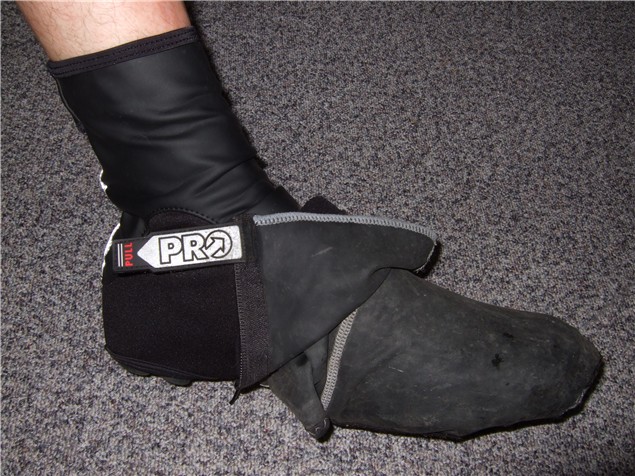
In my experience, which on this subject dates back some three decades, overshoes are not very effective at keeping splash and rain water away from a cyclist’s feet. They are, for sure, better than nothing and, quite possibly, more effective than plastic bags placed inside socks; I can’t be sure of this, since putting plastic bags inside my socks in an effort to keep my feet dry is an action even I, fond as I am of the home-brewed answer to cycling’s little inconveniences, cannot contemplate with equanimity.
Trouble is, not only do overshoes let water in via the top, but even the best of them are not, in fact, waterproof. Water-resistant is the preferrable term and, just as with wristwatches, indicates nothing more than a level of protection rather than absolute “proofness”. A wristwatch might be water-resistant to a depth of 50m, indicating that its casing will keep water out at the pressure imposed at 50m.
Some similar sort of measure should surely be applicable to overshoes; water-resistant for the first 10 minutes of a really hard cloudburst when worn while riding a bike with full-length mudguards and a mudflap in good working order, perhaps. Or, more accurately when attempting to gauge the capabilities of the pale blue rubbishy things on which I squandered money in about 1982, for about the first 10 seconds of a light, drizzly precipitation on dry roads. Which wouldn’t have been so bad were it not for the fleece inner lining, which readily absorbed the moisture that fell on and passed through the outer surface and which quickly became sodden, heavy and amazingly effective at conducting heat away from the foot.
Anyway, the last few weeks have offered ample opportunity for experiment in pursuit of the foot covering effective in very cold and or wet conditions. This pursuit has taken me up a few blind alleys, the shortest and most completely blocked of them revealed when I tried wearing DeFeet oversocks under Pro Endure overshoes in an attempt to combine the insulating effect of air trapped by the oversock with the water-resistance of the overshoes.
Instead, I got the equivalent of winding several rolls of bog paper around each shoe and dipping it in a puddle of freezing water before wrapping the whole lot inside a carrier bag. How did the water get in? Hard to say, but my suspicions were alerted by a tidemark of silt around the undersurface of the socks, indicating that it was being sucked up, blotting paper-style, by the socks from the pedal and heel openings. The idea worked brilliantly in dry weather, by the way.
The last two variations on this theme have been the most successful and have been based on the not very original idea of wearing two pairs of overshoes at once. For this to work at all, the inner pair must be very thin and tight fitting. Step forward Prendas Ciclismo with overshoes that might have been designed for the task.
Water-resistant they are not, at least for very long, but that’s because only the upper surface is of a suitable material while the side panels are in a plain ThermoLycra style fabric. Pull a pair of those Pro Endure overshoes on top and the amount of water that reaches the Prendas ones is reduced to the merest trickle. This they can deal with for a while and, even when the water starts to get through, there is not much of it.
That said, the effect of these two combined is bulky while offering little by way of insulation, which is why, when I found an old pair of Giordana Neoprene booties in my shed, I had an idea. Completely open to the elements at the top, the booties nevertheless have a few fine qualities. They are easy to pull on, easy to rinse clean under running water and then quick to dry. Most importantly, they do offer some insulation when wet.
This, then, is the current combo of choice. What water comes in over the top of the booties may wet the Prendas overshoes, but the feet stay reasonably warm thanks to the insulation afforded by the Neoprene rubber. Unless the weather is as unpleasant as it was yesterday…







